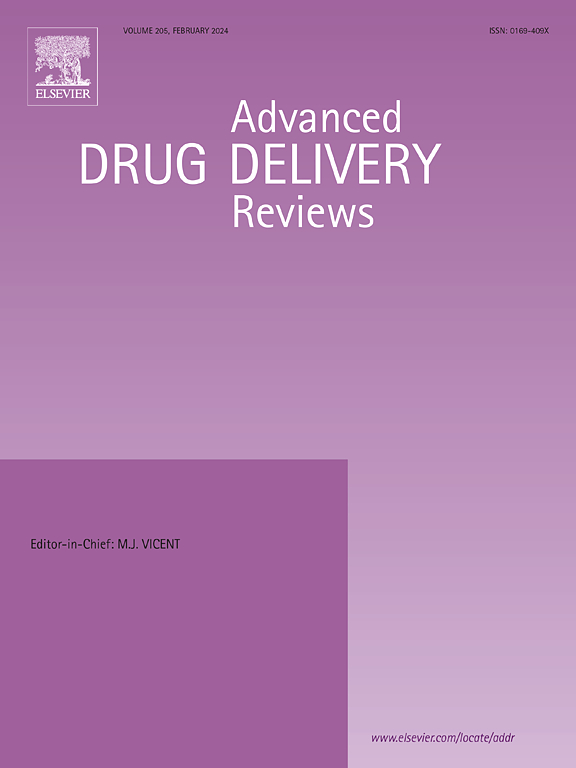DNA nanotechnology in oligonucleotide drug delivery systems: Prospects for Bio-nanorobots in cancer treatment
IF 17.6
1区 医学
Q1 PHARMACOLOGY & PHARMACY
引用次数: 0
Abstract
DNA-based nanomaterials have demonstrated significant potential in various applications due to their unique properties, including DNA’s diverse molecular interactions, programmability, and versatility with biological modules. Meanwhile, the DNA origami platforms have shown promise in the creation of drug carriers. This technique has paved the way for the production of nanomachines with outstanding performance. Moreover, DNA’s encoding capability and its massive parallelism help us to manipulate it for DNA computation. The DNA nanotechnology method holds potential, particularly for oligonucleotide therapeutics that enable precision medicine for cancers.
In this review, we explore the potential of DNA nanotechnology in this context, focusing on the DNA origami method and its production challenges, and proposing streamlined methods to enhance scalability and efficiency by enzymatic tools in life-like artificial systems. We then delve into studies demonstrating the application of DNA nanotechnology in delivering oligonucleotide drugs for tumor targeting. Following this, we assess DNA-based dynamic nanodevices that can be activated through molecular binding, environmental stimuli, and external field manipulation. Subsequently, we investigate the significance of DNA computation in the production of logic gates, DNA circuits, data storage, and machine learning, along with its role in drug delivery approaches.
By systematically classifying DNA robots according to their fundamental operating mechanisms, Machinery DNA Robots (MDNARs) and Computational DNA Robots (CDNARs), we pave the way for next-generation ’Bio-nanorobots.’ These advanced systems can integrate DNA computation with dynamic DNA machinery to enable precision cancer therapeutics through intelligent molecular-scale operations.


DNA纳米技术在寡核苷酸药物传递系统中的应用:生物纳米机器人在癌症治疗中的前景
基于DNA的纳米材料由于其独特的性质,包括DNA不同的分子相互作用、可编程性和与生物模块的通用性,在各种应用中显示出巨大的潜力。与此同时,DNA折纸平台在制造药物载体方面显示出了希望。这项技术为生产性能优异的纳米机器铺平了道路。此外,DNA的编码能力及其巨大的并行性帮助我们操纵它进行DNA计算。DNA纳米技术方法具有潜力,特别是在寡核苷酸治疗方面,使癌症的精确医学成为可能。在这篇综述中,我们探讨了DNA纳米技术在这一背景下的潜力,重点关注DNA折纸方法及其生产挑战,并提出了简化的方法,以提高酶工具在类生命人工系统中的可扩展性和效率。然后,我们深入研究了DNA纳米技术在肿瘤靶向递送寡核苷酸药物中的应用。在此之后,我们评估了基于dna的动态纳米器件,这些器件可以通过分子结合、环境刺激和外场操作激活。随后,我们研究了DNA计算在逻辑门、DNA电路、数据存储和机器学习的生产中的意义,以及它在药物递送方法中的作用。通过对DNA机器人的基本操作机制进行系统分类,机械DNA机器人(machine DNA robots, MDNARs)和计算DNA机器人(Computational DNA robots, CDNARs),我们为下一代生物纳米机器人铺平了道路。“这些先进的系统可以将DNA计算与动态DNA机器结合起来,通过智能分子尺度的操作实现精确的癌症治疗。”
本文章由计算机程序翻译,如有差异,请以英文原文为准。
求助全文
约1分钟内获得全文
求助全文
来源期刊
CiteScore
28.10
自引率
5.00%
发文量
294
审稿时长
15.1 weeks
期刊介绍:
The aim of the Journal is to provide a forum for the critical analysis of advanced drug and gene delivery systems and their applications in human and veterinary medicine. The Journal has a broad scope, covering the key issues for effective drug and gene delivery, from administration to site-specific delivery.
In general, the Journal publishes review articles in a Theme Issue format. Each Theme Issue provides a comprehensive and critical examination of current and emerging research on the design and development of advanced drug and gene delivery systems and their application to experimental and clinical therapeutics. The goal is to illustrate the pivotal role of a multidisciplinary approach to modern drug delivery, encompassing the application of sound biological and physicochemical principles to the engineering of drug delivery systems to meet the therapeutic need at hand. Importantly the Editorial Team of ADDR asks that the authors effectively window the extensive volume of literature, pick the important contributions and explain their importance, produce a forward looking identification of the challenges facing the field and produce a Conclusions section with expert recommendations to address the issues.

 求助内容:
求助内容: 应助结果提醒方式:
应助结果提醒方式:


